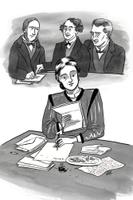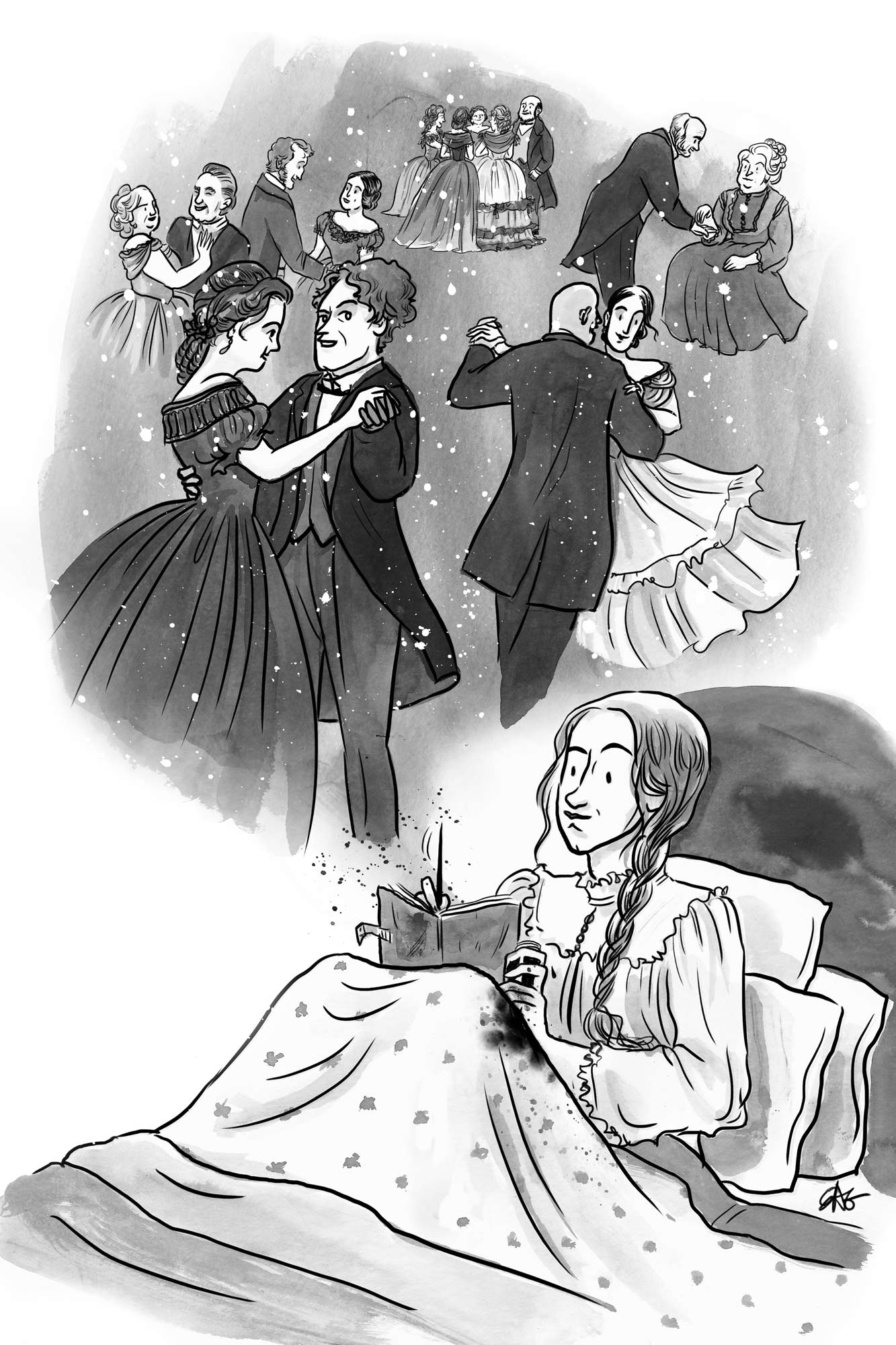
Anne Brown, née Nelson, wife, mother (born 1827 in Edinburgh, Scotland; died 6 May 1906 in Edinburgh). The wife of Father of Confederation George Brown, Anne Nelson Brown is credited with influencing her husband’s worldview and bringing out his softer side. She is often seen as having indirectly played an instrumental role in Confederation. Her correspondence with Brown during the Charlottetown and Québec Conferences provides a chronicle of the 1864 meetings for which there are no official records.
Early Life
The daughter of a prominent Edinburgh publisher, Anne Nelson was born into a wealthy family. Described as a lively, lighthearted and engaging woman, she was known to be very intelligent, firm-minded and cultured. Nelson had numerous European contacts, having studied in Germany and lived in Paris; she could speak both German and French.
Marriage to George Brown
Anne Nelson met George Brown, a Canadian newspaperman and politician, while he was travelling in Great Britain in 1862 to recuperate from illness. The previous year, he had left behind his Toronto newspaper the Globe and his seat in the Legislative Assembly of the Province of Canada. During his trip, Brown was invited by former schoolmate Thomas Nelson to spend a weekend with his family in Edinburgh. It was there that Brown met Thomas’ sister Anne Nelson, a decade his junior. He quickly became smitten. Nelson was better educated and more widely cultured than Brown, but this allowed them to share lively discussions. Within weeks he proposed. They married on 27 November 1862, and moved to Toronto in late December.
Politically, Brown was known for both abrasiveness and firm character (see Grit and Clear Grit), and the 43-year-old bachelor was seen as somewhat cheerless and severe. His time in Britain, and his marriage, marked the beginning of his shift in attitude. He declared he’d returned to Toronto “with a better knowledge of public affairs and with more ardent desire to serve.” Anne didn’t stand in George’s way when he re-entered politics in March 1863. However, there is some indication that she regretted the choice. She was never at ease with Brown’s political career, which took him to the Legislative Assembly in Québec City for long stretches, and begged him in her letters to “never speak of settling down here for life. The idea of being buried here is dreadful to me.”
Letters Home
George Brown sent Anne near-daily letters, providing an ample source of information about Anne’s influence over her husband. Though many of his letters are preserved, few of Anne’s have survived; George could not stand the thought of others seeing his wife’s letters and would usually destroy them. Surviving letters from Anne are those George returned to her with comments in the margins.
George wrote to Anne from his seat in the Legislative Assembly during the early months of 1864. These letters suggest Brown’s sense of detachment from politics. In them, he awaits the end of session, so that he can return to Anne and their infant daughter, Margaret. When George wasn’t at work, he mainly spent his time alone waiting for Anne’s letters to arrive. Separated from his wife and baby, he at one point called himself “a fool” for having returned to politics.
Changing Politics
In letters dated mid to late June 1864, George Brown longs for Anne’s presence so that she might advise him on how to handle certain matters of parliament. On 14 June, an all-party parliamentary committee chaired by George reported in favour of a federalized system of government —separate provinces linked by a new federal parliament — that would help overcome the sectionalism that had brought the Province of Canada to political deadlock (see Great Coalition). This period was a turning point in Canadian history, a fact not lost on George. He expressed nerves about upcoming motions and felt negotiations were at a critical point:
How I do wish you were here to advise me. You cannot tell how I wish you had been. But never mind, I will try to do my duty to the country in such a manner as you my dearest Anne, will not be ashamed of.
Anne, in turn, showed pride in her husband, sending him newspaper clippings about his speeches.
George’s letters show he was initially reluctant to enter a coalition government with his political rivals; John A. Macdonald was insistent that George prove his commitment to political reform by entering the new ministry. George wrote to Anne, conflicted between his desire to end his political career and to have the power to settle the sectional troubles of Canada. It seemed that he might now be prepared to do what he’d previously seen as unthinkable — join forces with Macdonald and George-Étienne Cartier to work toward the union of British North America.
By August 1864, George was writing Anne to inform her that a federal constitution scheme was being drafted. Historian Frank Underhill credits George’s willingness to partner with his political foes in the name of Confederation to Anne’s mellowing influence. “Perhaps the real father of Confederation was Mrs. Brown,” he said.
Confederation
Though there are no official records from the Charlottetown and Québec Conferences, Anne’s daily correspondence with George Brown provides a chronicle of the 1864 meetings. His letters outline conference progress, dinner menus, and the people and politicians he was meeting. He’d often write of the heated debates taking place, and reflect on his stance on representation by population. George relates the events of 3 September 1864, when Province of Canada delegates entertained Atlantic delegates aboard the Queen Victoria steamer:
Cartier and I made eloquent speeches — of course — and whether as a result of our eloquence or of the goodness of our champagne, the ice became completely broken, the tongues of the delegates wagged merrily and the banns of matrimony between all Provinces of British North America having been formally proclaimed and all manner of persons duly warned then, there and then to speak or forever after hold their tongues — no man appeared to forbid the banns and the union was therefore formally completed and proclaimed!
He excitedly wrote to Anne on 27 October 1864 as the Québec Conference concluded to tell her the constitution had been adopted:
All right!!! Conference through at six o’clock this evening — constitution adopted — a most creditable document — a complete reform of all the abuses and injustices we have complained of! […] You will say that our constitution is dreadfully Tory — and so it is — but we have the power in our hands (if it passes) to change it as we like! Hurrah!
George acknowledged what Anne sacrificed for them to be apart for much of 1864 as Confederation was negotiated. “Perhaps we should be happy that our sacrifices have had so much effect on the welfare of half a continent,” he wrote. George then carried the proposed plan of Confederation to England that December for discussions with the imperial government. It was after those meetings that he was reunited with Anne and child, who had spent much of the year in Scotland.
Life after Politics
George Brown also wrote letters to Anne’s mother, where he indicated he always did as Anne said and that Anne didn’t want him to be in politics much longer:
I am half sorry I came back to parliament and yet it would have been difficult for my political friends to get along without me under present circumstances. Anne says, however, I am not to run again, and as I always do as she tells me, I suppose this parliamentary life will not trouble us long.
George resigned from Cabinet on 19 December 1865 over internal dissensions. He sent a telegram to Anne declaring: “Thank Providence — I am a free man once more.”
He was then able to focus more on his family life with Anne and their three children. However, on 25 March 1880, a disgruntled newspaper employee shot Brown. An infection developed in the wound, and he died on 9 May 1880. Anne and the children subsequently moved to Scotland. She died 6 May 1906 and is buried in Dean Cemetery in Edinburgh.
Legacy
Anne Nelson Brown is often labeled as the Mother of Confederation, a title also attached to Queen Victoria. Historians debate her significance in Canadian history, but her correspondence with her husband provides rare documentation of the Charlottetown and Québec Conferences.

 Share on Facebook
Share on Facebook Share on X
Share on X Share by Email
Share by Email Share on Google Classroom
Share on Google Classroom


